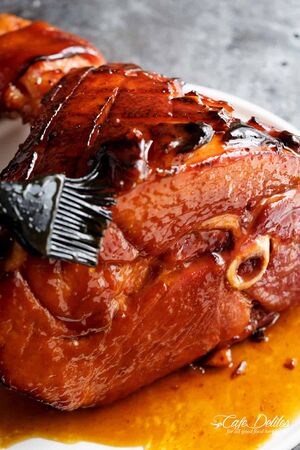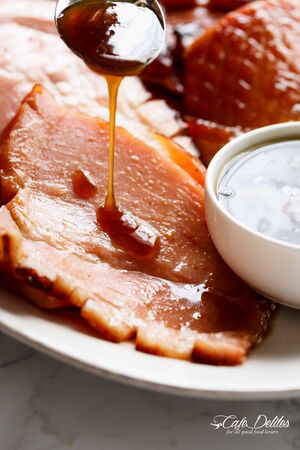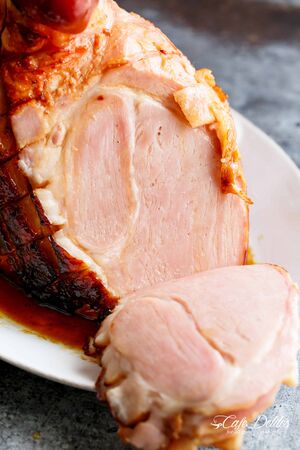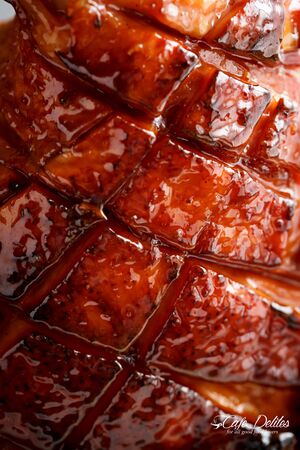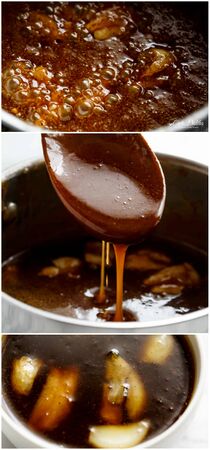Brown Sugar Mustard Glazed Ham
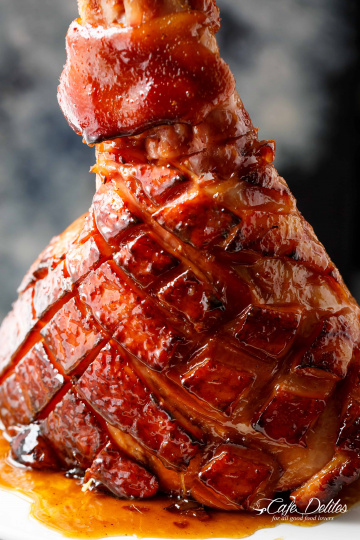
| Prep | Cook | Total | Serves |
|---|---|---|---|
| 15 Min | 1 Hr 15 Min | 1 Hr 30 Min | 25 People |
INGREDIENTS
- 8-10 pound (4-5 kg) bone-in fully cooked ham,
- 1/2 cup water
- 1/2 cup unsalted butter, reduce fat or full fat
- 1 cup brown sugar
- 1/2 cup honey
- 2 tablespoons Dijon mustard
- 1/4 teaspoon ground cinnamon
- 1/4 teaspoon ground cloves
- 4 cloves garlic, smashed
INSTRUCTIONS
- Preheat the oven to 300°F | 150°C and arrange a rack in the lower third. Remove any plastic packaging or netting from the ham. Trim away the rind and discard. Set the ham aside to rest at room temperature for 1-2 hours.
- Line a baking tray or dish with several sheets of aluminium foil or parchment paper if you prefer (it will make cleanup a lot easier).
- Remove the rind or skin of the ham (refer to steps in post), ensuring you leave the fat on. Using a sharp knife score a 1-inch-wide diamond pattern (don’t cut more than 1/4 inch deep) over the entire ham. Place the ham in the baking tray; pour 1/3 cup of water into the base of the pan and cover the ham with two pieces of foil or parchment paper and bake for 30 minutes.
- Meanwhile, heat the butter in a small pot or saucepan over medium heat until golden browned. Add in the brown sugar, honey, mustard, cinnamon and cloves, stirring to mix together well until the brown sugar has completely dissolved, (about 2 minutes).
- Reduce heat to low and add in the garlic. Allow it to become fragrant, cooking for a further minute or two until the glaze just begins to simmer, then set it aside and let cool to lukewarm (the glaze should be the consistency of room-temperature honey).
- After 30 minutes baking time, carefully remove the ham from the oven and increase the oven temperature to 425°F | 220°C. Discard the foil or parchment paper and pour 1/3 of the glaze all over the ham, brushing in between the cuts to evenly cover. Return to the oven and bake uncovered for 15 minutes.
- Remove from the oven, brush with another third of the glaze and some of the pan juices, and repeat again after 15 minutes more minutes of baking until a dark golden-brown crust has formed, (about 30 minutes total). For added depth of flavour, mix some of the ham pan juices together with the glaze in the pot which will help keep it runny enough for brushing. If your crust is still pink after there suggested baking time, turn on your broiler (or oven grill), and allow it to broil for 2-5 minutes, while keeping an eye on it so it doesn't burn from the sugar.
- Let the ham rest 10-20 minutes before slicing.
NOTES
- If your glaze has been over simmered and begins to thicken between each baste, add some of the pan juices to it and heat it up over low heat until it warms through and is the consistency of warmed honey.
Tips for The Best Ham Glaze
My biggest piece of advice is not to simmer the glaze for too long, as you will end up with a hard caramel once it begins to cool, and it’s extremely difficult to slather onto the outside of the ham when glazing. You want to bring it to a gentle simmer and take it off the heat quickly.
I added the pan juices from the ham into the glaze once there were pan juices to use, and WOW! Amazing flavours! My ham wasn’t salty though, so make sure you do some taste testing before adding the juices and add the amount you need to alter the flavour even more.
Baste
Glaze and baste and baste and glaze and GO NUTS with it. The more the merrier, and ’tis the season, right?
I wish there was smell-ernet happening right about now, because juicy, tender Brown Sugar Mustard Glazed Ham smells just as good as it looks.
How To Remove Ham Rind
When you buy your ham, you’ll notice right underneath the rind there is a gorgeous layer off fat. DON’T trim this away. This fat turns into a beautiful crispy and sticky coating for your glaze and is DIVINE.
To show you, I’ve put together the following EASY steps OR CHECK OUT THE VIDEO ABOVE:
- Cut a line through the skin all around the shank end.
- Insert a sharp knife between the rind and fat and run it along to detach both layers.
- Using your fingers, gently separate the rind from the fat. You can insert your hand deeper into the ham to keep detaching it so it’s easier to peel the rind off in Step 4.
- Peel off and discard the rind.
- Run knife cutting into the fat layer about 1/4-inch deep to lightly score diamond pattern all over the surface.
Once your ham is in the oven, get started on your glaze.
